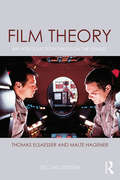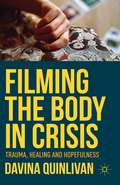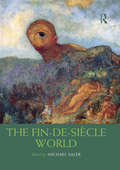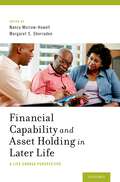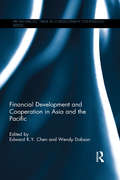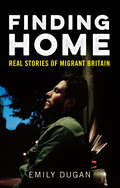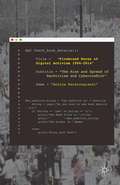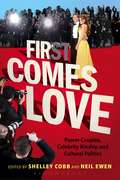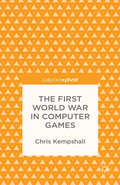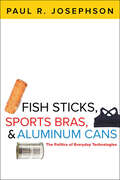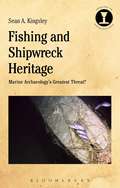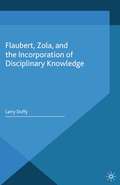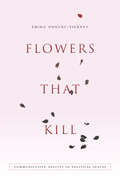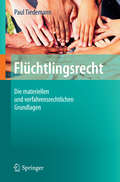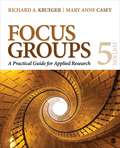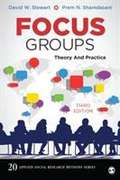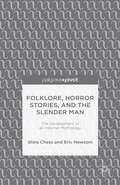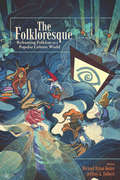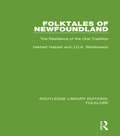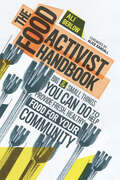- Table View
- List View
Film Theory: An Introduction through the Senses
by Thomas Elsaesser Malte HagenerWhat is the relationship between cinema and spectator? This is the key question for film theory, and one that Thomas Elsaesser and Malte Hagener put at the center of their insightful and engaging book, now revised from its popular first edition. Every kind of cinema (and every film theory) first imagines an ideal spectator, and then maps certain dynamic interactions between the screen and the spectator’s mind, body and senses. Using seven distinctive configurations of spectator and screen that move progressively from ‘exterior’ to ‘interior’ relationships, the authors retrace the most important stages of film theory from its beginnings to the present—from neo-realist and modernist theories to psychoanalytic, ‘apparatus,’ phenomenological and cognitivist theories, and including recent cross-overs with philosophy and neurology. This new and updated edition of Film Theory: An Introduction through the Senses has been extensively revised and rewritten throughout, incorporating discussion of contemporary films like Her and Gravity, and including a greatly expanded final chapter, which brings film theory fully into the digital age.
Filming the Body in Crisis: Trauma, Healing and Hopefulness
by Davina QuinlivanHow does film affect the way we understand crises of the body and mind and how does it manifest other kinds of crises levelled at the spectator? This book offers vital scholarly analysis of the embodied nature of film viewing and the ways in which film deals with the question of loss, the healing body and its material registering of trauma.
The Fin-de-Siècle World (Routledge Worlds)
by Michael SalerThis comprehensive and beautifully illustrated collection of essays conveys a vivid picture of a fascinating and hugely significant period in history, the Fin de Siècle. Featuring contributions from over forty international scholars, this book takes a thematic approach to a period of huge upheaval across all walks of life, and is truly innovative in examining the Fin de Siècle from a global perspective. The volume includes pathbreaking essays on how the period was experienced not only in Europe and North America, but also in China, Japan, the Middle East, Latin America, Africa, India, and elsewhere across the globe. Thematic topics covered include new concepts of time and space, globalization, the city, and new political movements including nationalism, the "New Liberalism", and socialism and communism. The volume also looks at the development of mass media over this period and emerging trends in culture, such as advertising and consumption, film and publishing, as well as the technological and scientific changes that shaped the world at the turn of the nineteenth century, such as the invention of the telephone, new transport systems, eugenics and physics. The Fin-de-Siècle World also considers issues such as selfhood through chapters looking at gender, sexuality, adolescence, race and class, and considers the importance of different religions, both old and new, at the turn of the century. Finally the volume examines significant and emerging trends in art, music and literature alongside movements such as realism and aestheticism. This volume conveys a vivid picture of how politics, religion, popular and artistic culture, social practices and scientific endeavours fitted together in an exciting world of change. It will be invaluable reading for all students and scholars of the Fin-de-Siècle period.
The Fin-de-Siècle World (Routledge Worlds)
by Michael SalerThis comprehensive and beautifully illustrated collection of essays conveys a vivid picture of a fascinating and hugely significant period in history, the Fin de Siècle. Featuring contributions from over forty international scholars, this book takes a thematic approach to a period of huge upheaval across all walks of life, and is truly innovative in examining the Fin de Siècle from a global perspective. The volume includes pathbreaking essays on how the period was experienced not only in Europe and North America, but also in China, Japan, the Middle East, Latin America, Africa, India, and elsewhere across the globe. Thematic topics covered include new concepts of time and space, globalization, the city, and new political movements including nationalism, the "New Liberalism", and socialism and communism. The volume also looks at the development of mass media over this period and emerging trends in culture, such as advertising and consumption, film and publishing, as well as the technological and scientific changes that shaped the world at the turn of the nineteenth century, such as the invention of the telephone, new transport systems, eugenics and physics. The Fin-de-Siècle World also considers issues such as selfhood through chapters looking at gender, sexuality, adolescence, race and class, and considers the importance of different religions, both old and new, at the turn of the century. Finally the volume examines significant and emerging trends in art, music and literature alongside movements such as realism and aestheticism. This volume conveys a vivid picture of how politics, religion, popular and artistic culture, social practices and scientific endeavours fitted together in an exciting world of change. It will be invaluable reading for all students and scholars of the Fin-de-Siècle period.
Financial Capability and Asset Holding in Later Life: A Life Course Perspective
by Nancy Morrow-Howell and Margaret S. SherradenWith today's availability of Social Security and Medicare, we typically think of the older years as a stage in life where people are supported financially. However, of the more than 40 million old adults currently living in the US, many are struggling financially living below or near the poverty line. They are lacking the assets necessary to see them through a period of life that is often longer than expected and that requires more health and long-term care. While financial vulnerability can be most pronounced in old age, it is often created across decades, revealing itself in later years when there is little opportunity to reverse a lifetime of disadvantage. The concept of Financial Capability refers to both an individual and structural idea that combines a person's ability to act with their opportunity to act in their best financial interests. In Financial Capability and Asset Holding in Later Life: A Life Course Perspective the concept of Financial Capability is used to underscore the importance of acquiring knowledge and skills while addressing policies and services than can build financial security. The volume assembles the latest evidence on financial capability and assets among older adults using a life course perspective, arguing that older adults need financial knowledge and financial services in order to build secure lives, and that this process needs to begin before it is too late to make effective changes and choices. Broken into three parts, the book's chapters - written by leading experts in the field - blend together empirical findings, economic and social theory, and case studies. Part 1 opens the book with a conceptual and empirical overview of financial capability and assets among older adults using a life course perspective. Part 2 presents chapters addressing financial vulnerability of diverse racial and ethnic groups, people with disabilities, and immigrants. Part 3 includes chapters describing current policies, programs, and innovations, including a review of important issues of working and caregiving in later life, and a detailed assessment of "age-friendly" banking principles, banking products, services, and policies.
Financial Development and Cooperation in Asia and the Pacific (PAFTAD (Pacific Trade and Development Conference Series))
by Edward K. Y. Chen Wendy Dobson Wendy K. DobsonThe 1997–8 Asian financial crisis exposed weaknesses in the region’s national financial systems, but since then East Asia has become the world’s most dynamic economic region. Domestic financial systems have developed, cross-border financial flows within the region are growing apace as demand from governments and large firms increases and as the capabilities of financial institutions develop, and governments have initiated regional cooperation aimed at preventing future crises and managing them if they occur. This book examines the economies of Asia and the Pacific with reference to financial reform and liberalization, monetary policy frameworks, banking and capital markets, regulation and supervision and macroeconomic policies. Further, it asks what lessons have been learned from both the Asian financial crisis and the recent financial crisis, how to engender financial stability in the region, and how to ensure that the benefits of economic growth and financial development reach all members of society. Across four key sections, the chapters examine the future implications of historical studies of the relationships between financial development and growth; financial development including banks, non-bank financial institutions and capital markets; how financial stability is being sought in the region; and China’s plans for capital account opening and renminbi internationalization and subsequent the policy implications for China’s neighbours. This book draws on papers originally presented to the 36th Pacific Trade and Development Conference held in Hong Kong in 2013, and features contributions from leading academics and economists from around the world. As such, it will be of great interest to students and scholars of Asian economics, Asia Pacific studies, international economics and international finance.
Financial Development and Cooperation in Asia and the Pacific (PAFTAD (Pacific Trade and Development Conference Series))
by Edward K.Y. Chen Wendy DobsonThe 1997–8 Asian financial crisis exposed weaknesses in the region’s national financial systems, but since then East Asia has become the world’s most dynamic economic region. Domestic financial systems have developed, cross-border financial flows within the region are growing apace as demand from governments and large firms increases and as the capabilities of financial institutions develop, and governments have initiated regional cooperation aimed at preventing future crises and managing them if they occur. This book examines the economies of Asia and the Pacific with reference to financial reform and liberalization, monetary policy frameworks, banking and capital markets, regulation and supervision and macroeconomic policies. Further, it asks what lessons have been learned from both the Asian financial crisis and the recent financial crisis, how to engender financial stability in the region, and how to ensure that the benefits of economic growth and financial development reach all members of society. Across four key sections, the chapters examine the future implications of historical studies of the relationships between financial development and growth; financial development including banks, non-bank financial institutions and capital markets; how financial stability is being sought in the region; and China’s plans for capital account opening and renminbi internationalization and subsequent the policy implications for China’s neighbours. This book draws on papers originally presented to the 36th Pacific Trade and Development Conference held in Hong Kong in 2013, and features contributions from leading academics and economists from around the world. As such, it will be of great interest to students and scholars of Asian economics, Asia Pacific studies, international economics and international finance.
Finding Home: The Real Stories of Migrant Britain
by Emily DuganAward-winning reporter Emily Dugan’s Finding Home follows the tumultuous lives of a group of immigrants, all facing intense challenges in their quest to live in the UK. Syrian refugee Emad set up the Free Syrian League and worked illegally in the UK to pay for his mother to be smuggled across the Mediterranean on a perilous trip from Turkey. Even if she survives the journey, Emad knows it will be an uphill struggle to get her into Britain. Australian therapist Harley risks deportation despite serving the NHS for ten years and being told by the Home Office she could stay. Teaching assistant Klaudia is one of thousands of Polish people now living in Boston, Lincolnshire – a microcosm of poorly managed migration. Aderonke, a leading Manchester LGBT activist, lives in a tiny B&B room in Salford with her girlfriend, Happiness, and faces deportation and persecution. Dugan’s timely and acutely observed book reveals the intense personal dramas of ordinary men and women as they struggle to find somewhere to call home. It shows that migration is not about numbers, votes or opinions: it is about people.
Firebrand Waves of Digital Activism 1994-2014: The Rise and Spread of Hacktivism and Cyberconflict
by Athina KaratzogianniThis book introduces four waves of upsurge in digital activism and cyberconflict. The rise of digital activism started in 1994, was transformed by the events of 9/11, culminated in 2011 with the Arab Spring uprisings, and entered a transformative phase of control and mainstreaming since 2013 with the Snowden affair.
First Comes Love: Power Couples, Celebrity Kinship and Cultural Politics
by Shelley Cobb Neil EwenWith the prominence of one-name couples (Brangelina, Kimye) and famous families (the Smiths, the Beckhams), it is becoming increasingly clear that celebrity is no longer an individual pursuit-if it ever was. Accordingly, First Comes Love explores celebrity kinship and the phenomenon of the power couple: those relationships where two stars come together and where their individual identities as celebrities become inseparable from their status as a famous twosome. Taken together, the chapters in this volume interrogate the ways these alliances are bound up in wider cultural debates about marriage, love, intimacy, family, parenthood, sexuality, and gender, in their particular historical contexts, from the 1920s to the present day. Interdisciplinary in scope, First Comes Love seeks to establish how celebrity relationships play particular roles in dramatizing, disrupting, and reconciling often-contradictory ideas about coupledom and kinship formations.
First Comes Love: Power Couples, Celebrity Kinship and Cultural Politics
by Shelley Cobb Neil EwenWith the prominence of one-name couples (Brangelina, Kimye) and famous families (the Smiths, the Beckhams), it is becoming increasingly clear that celebrity is no longer an individual pursuit-if it ever was. Accordingly, First Comes Love explores celebrity kinship and the phenomenon of the power couple: those relationships where two stars come together and where their individual identities as celebrities become inseparable from their status as a famous twosome. Taken together, the chapters in this volume interrogate the ways these alliances are bound up in wider cultural debates about marriage, love, intimacy, family, parenthood, sexuality, and gender, in their particular historical contexts, from the 1920s to the present day. Interdisciplinary in scope, First Comes Love seeks to establish how celebrity relationships play particular roles in dramatizing, disrupting, and reconciling often-contradictory ideas about coupledom and kinship formations.
The First World War in Computer Games
by C. KempshallThe First World War in Computer Games analyses the depiction of combat, the landscape of the trenches, and concepts of how the war ended through computer games. This book explores how computer games are at the forefront of new representations of the First World War.
Fish Sticks, Sports Bras, and Aluminum Cans: The Politics of Everyday Technologies
by Paul R. JosephsonWho would have guessed that the first sports bra was made out of two jockstraps sewn together or that it succeeded because of federal anti-discrimination laws? What do simple decisions about where to build a road or whether to buy into the carbon economy have to do with Hurricane Katrina or the Fukushima nuclear disaster? How did massive flood control projects on the Mississippi River and New Deal dams on the Columbia River lead to the ubiquity of high fructose corn syrup? And what explains the creationâ€�and continued popularityâ€�of the humble fish stick? In Fish Sticks, Sports Bras, and Aluminum Cans, historian Paul R. Josephson explores the surprising origins, political contexts, and social meanings of ordinary objects. Drawing on archival materials, technical journals, interviews, and field research, this engaging collection of essays reveals the forces that shape (and are shaped by) everyday objects. Ultimately, Josephson suggests that the most familiar and comfortable objectsâ€�sugar and aluminum, for example, which are inextricably tied together by their linked history of slavery and colonialismâ€�may have the more astounding and troubling origins. Students of consumer studies and the history of technology, as well as scholars and general readers, will be captivated by Josephson’s insights into the complex relationship between society and technology.
Fishing and Shipwreck Heritage: Marine Archaeology's Greatest Threat? (Debates in Archaeology)
by Sean A. KingsleyFor 250 years encrusted wonders have been turning up in fishermen's nets: everything imaginable from prehistoric animal bones to priceless Roman statues. Fishing trawlers annually sweep an area equivalent in size to half the world's continental shelves. Everything in the wake of these bulldozers of the deep is battered. A devastating trail of smashed shipwrecks runs from the North Sea to Malaysia.The profound threat of the global fishing industry remains a black hole in marine archaeology, poorly understood and unmanaged. Fishing and Shipwreck Heritage is the first global analysis of the threat of bottom fishing to underwater cultural heritage, examining the diversity, scale and implications on endangered finds and sites. Throughout, the key questions of whether it is too late to save the planet's three million wrecks and how sustainable management is achievable are debated.
Fishing and Shipwreck Heritage: Marine Archaeology's Greatest Threat? (Debates in Archaeology)
by Sean A. KingsleyFor 250 years encrusted wonders have been turning up in fishermen's nets: everything imaginable from prehistoric animal bones to priceless Roman statues. Fishing trawlers annually sweep an area equivalent in size to half the world's continental shelves. Everything in the wake of these bulldozers of the deep is battered. A devastating trail of smashed shipwrecks runs from the North Sea to Malaysia.The profound threat of the global fishing industry remains a black hole in marine archaeology, poorly understood and unmanaged. Fishing and Shipwreck Heritage is the first global analysis of the threat of bottom fishing to underwater cultural heritage, examining the diversity, scale and implications on endangered finds and sites. Throughout, the key questions of whether it is too late to save the planet's three million wrecks and how sustainable management is achievable are debated.
Flaubert, Zola, and the Incorporation of Disciplinary Knowledge (Palgrave Studies in Modern European Literature)
by L. DuffyThis book is about how France's two major documentary authors of the nineteenth century – Gustave Flaubert and Émile Zola – incorporate medical knowledge about the body into their works, and in so doing exploit its metaphorical potential of the body to engage in critical reflection about the accumulation and reconfiguration of knowledge.
Flowers That Kill: Communicative Opacity in Political Spaces
by Emiko Ohnuki-TierneyFlowers are beautiful. People often communicate their love, sorrow, and other feelings to each other by offering flowers, like roses. Flowers can also be symbols of collective identity, as cherry blossoms are for the Japanese. But, are they also deceptive? Do people become aware when their meaning changes, perhaps as flowers are deployed by the state and dictators? Did people recognize that the roses they offered to Stalin and Hitler became a propaganda tool? Or were they like the Japanese, who, including the soldiers, did not realize when the state told them to fall like cherry blossoms, it meant their deaths? Flowers That Kill proposes an entirely new theoretical understanding of the role of quotidian symbols and their political significance to understand how they lead people, if indirectly, to wars, violence, and even self-exclusion and self-destruction precisely because symbolic communication is full of ambiguity and opacity. Using a broad comparative approach, Emiko Ohnuki-Tierney illustrates how the aesthetic and multiple meanings of symbols, and at times symbols without images become possible sources for creating opacity which prevents people from recognizing the shifting meaning of the symbols.
Flüchtlingsrecht: Die materiellen und verfahrensrechtlichen Grundlagen
by Paul TiedemannDas Buch vermittelt sowohl die gesetzlichen und rechtsdogmatischen Grundlagen des Flüchtlingsrechts als auch die Geschichte des Asylrechts, ferner stellt es Ansätze für eine philosophische Reflexion des Migrations- und Flüchtlingsrechts unter menschenrechtlichen Aspekten vor. Ausführungen zu Techniken der Sachverhaltsermittlung und der Erstellung von flüchtlingsrechtlichen Gutachten runden die Darstellung ab.
Focus Groups: A Practical Guide for Applied Research (5th Edition) (PDF)
by Richard Krueger Mary CaseyUsing an engaging, straightforward writing style, the authors draw on their more than 50 years of hands-on experience in the field to cut through theory and offer practical guidance on every facet of the focus process, including tips for avoiding problems and pitfalls.
Focus Groups: Theory And Practice (PDF) (Applied Social Research Methods Ser. #20)
by David Stewart Prem ShamdasaniThe fully updated Third Edition of Focus Groups: Theory and Practice offers a unique blend of focus group theory and practice in a single, easy-to-read source. It provides systematic treatment to the design, conduct, and interpretation of focus group data within the context of social science research and theory. Known for accessibility and step-by-step guidance, comprehensive treatment, and historical perspective, the book examines every facet of focus group research, from the selection and recruitment of group participants, to the selection of a moderator and conducting of interviews, to the analysis of focus group data. The Third Edition reflects the growing use of focus group research to address an increasingly broad array of issues that have a global span, and also provides more guidance on conducting virtual focus groups.
Folklore, Horror Stories, and the Slender Man: The Development of an Internet Mythology
by S. Chess E. NewsomThe Slender Man entered the general popular consciousness in May 2014, when two young girls led a third girl into a wooded area and stabbed her. Examining the growth of the online horror phenomenon, this book introduces unique attributes of digital culture and establishes a needed framework for studies of other Internet memes and mythologies.
The Folkloresque: Reframing Folklore in a Popular Culture World
by Michael Dylan Foster Jeffrey A. TolbertThis volume introduces a new concept to explore the dynamic relationship between folklore and popular culture: the “folkloresque.” With “folkloresque,” Foster and Tolbert name the product created when popular culture appropriates or reinvents folkloric themes, characters, and images. Such manufactured tropes are traditionally considered outside the purview of academic folklore study, but the folkloresque offers a frame for understanding them that is grounded in the discourse and theory of the discipline. Fantasy fiction, comic books, anime, video games, literature, professional storytelling and comedy, and even popular science writing all commonly incorporate elements from tradition or draw on basic folklore genres to inform their structure. Through three primary modes—integration, portrayal, and parody—the collection offers a set of heuristic tools for analysis of how folklore is increasingly used in these commercial and mass-market contexts. The Folkloresque challenges disciplinary and genre boundaries; suggests productive new approaches for interpreting folklore, popular culture, literature, film, and contemporary media; and encourages a rethinking of traditional works and older interpretive paradigms. Contributors: Trevor J. Blank, Chad Buterbaugh, Bill Ellis, Timothy H. Evans, Michael Dylan Foster, Carlea Holl-Jensen, Greg Kelley, Paul Manning, Daniel Peretti, Gregory Schrempp, Jeffrey A. Tolbert
Folktales of Newfoundland: The Resilience of the Oral Tradition (Routledge Library Editions: Folklore)
by Herbert Halpert J.D.A. WiddowsonThis collection of Newfoundland folk narratives, first published in 1996, grew out of extensive fieldwork in folk culture in the province. The intention was to collect as broad a spectrum of traditional material as possible, and Folktales of Newfoundland is notable not only for the number and quality of its narratives, but also for the format in which they are presented. A special transcription system conveys to the reader the accents and rhythms of each performance, and the endnote to each tale features an analysis of the narrator’s language. In addition, Newfoundland has preserved many aspects of English and Irish folk tradition, some of which are no longer active in the countries of their origin. Working from the premise that traditions virtually unknown in England might still survive in active form in Newfoundland, the researchers set out to discover if this was in fact the case.
Folktales of Newfoundland: The Resilience of the Oral Tradition (Routledge Library Editions: Folklore)
by Herbert Halpert J.D.A. WiddowsonThis collection of Newfoundland folk narratives, first published in 1996, grew out of extensive fieldwork in folk culture in the province. The intention was to collect as broad a spectrum of traditional material as possible, and Folktales of Newfoundland is notable not only for the number and quality of its narratives, but also for the format in which they are presented. A special transcription system conveys to the reader the accents and rhythms of each performance, and the endnote to each tale features an analysis of the narrator’s language. In addition, Newfoundland has preserved many aspects of English and Irish folk tradition, some of which are no longer active in the countries of their origin. Working from the premise that traditions virtually unknown in England might still survive in active form in Newfoundland, the researchers set out to discover if this was in fact the case.
The Food Activist Handbook: Big & Small Things You Can Do to Help Provide Fresh, Healthy Food for Your Community
by Ali BerlowA valuable guide packed with practical ways you can support your local food community and create access to healthy food for everyone.
